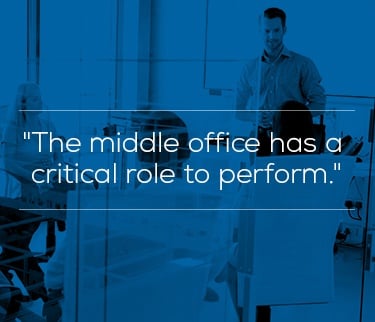Effective management of massive quantities of data pose a significant challenge to asset management firms. Yet given the right tools, middle offices can add real value to their organizations.

There are now more sources of information in greater volumes and with higher degrees of complexity than ever before. And, at the same time there are increasing demands for data and reporting from a variety of internal and external customers. The ever-growing task is how to address the deluge of data and harvest the rich value that it contains.
Technology is the key. Research by the Tabb Group explains the issue this way: “Technology is both the root cause and the solution to the problem. The proliferation of high-speed data devices has caused an exponential growth in the generation, capture, and reporting of data. On the other hand, given the complexity and diversity of the systems involved, technology is the only option for solving the problem.”
The role of the middle office
In its 2016 Global Asset Management & Administration Survey, Linedata sought the opinions of 200 respondents across the asset management sector. They identified three main challenges:
- adapting to new regulation
- maintaining operational efficiency
- cutting costs and managing data.
The response from those surveyed, in terms of their IT spending priorities were improving legacy systems, risk and compliance solutions and data management.
{{cta(‘d6fd8994-a61c-41af-bc37-c32e921f66a6’)}}
Middle offices are constantly handling a variety of data from various sources to produce a selection of reports to different stakeholders. These include the front office, risk management and performance areas, compliance, external regulators and, of course, increasingly demanding clients.
Having multiple performance systems for various asset classes and separate systems for risk, creates data silos that limit the value that can be extracted and the people that can access it. Consolidating systems is one way to be more effective, reducing the amount of output in different formats and enabling processing and management to be more centralized.
This is where the middle office has a critical role to perform. It first needs to develop a data consolidation strategy. Once that is in place, it can then control where the data inputs are coming from and restrict them to those that are consistent with its strategy. This will involve recognizing quality data sources and discouraging those that may be produced ad hoc by internal sources, perhaps on their own spreadsheets.
On the output side, the middle office can introduce further discipline. Outputs can follow consistent formats. The nature of those outputs can be adapted to the needs of users, although basic, core data will remain the same, stored in a central data store.
In other words, users can dip into the data and reporting pool, subject to appropriate authority, to seek the information they require. How they choose to visualize the data can also be specifically tailored to their needs. Part of the effective use of data lies in presenting it in graphic or tabular form so that valuable information is not lost in the data and time formerly squandered accessing it can be saved.
How users access data is also an important element. It will be convenient for some users to access data on mobile devices for example. Others will be best served through traditional office IT networks and screens.
The new middle office
Consequently the nature and structure of the new middle office can be remodelled to reflect its function as the gatekeeper and facilitator of an organisation’s core data. It becomes a conduit and manager of the data the enterprise receives and produces.
The result is a middle office that adds value by consolidating systems and workflows. It controls access to data and the output of it to teams and recipients in the business. By reducing the number of data formats, more users will become familiar with one format and be comfortable to work with it.
Performance, risk and compliance data come from a single data set and platform and client reporting will become more accurate, detailed and, above all, quicker. This effectiveness and efficiency can be derived from the tsunami of data with which the middle office is currently deluged.
Takeaways:
- Data consolidation is key
- A single data format facilitates efficiency and consistency
- Open access enables users to make best use of data
- Access control ensures that data reaches only those that need it
- Better presentation ensures users understand the data they receive
- The transition is from mass data to valuable, timely reporting
{{cta(‘ea469400-1800-49ca-b1ac-51b75df3fd87’)}}